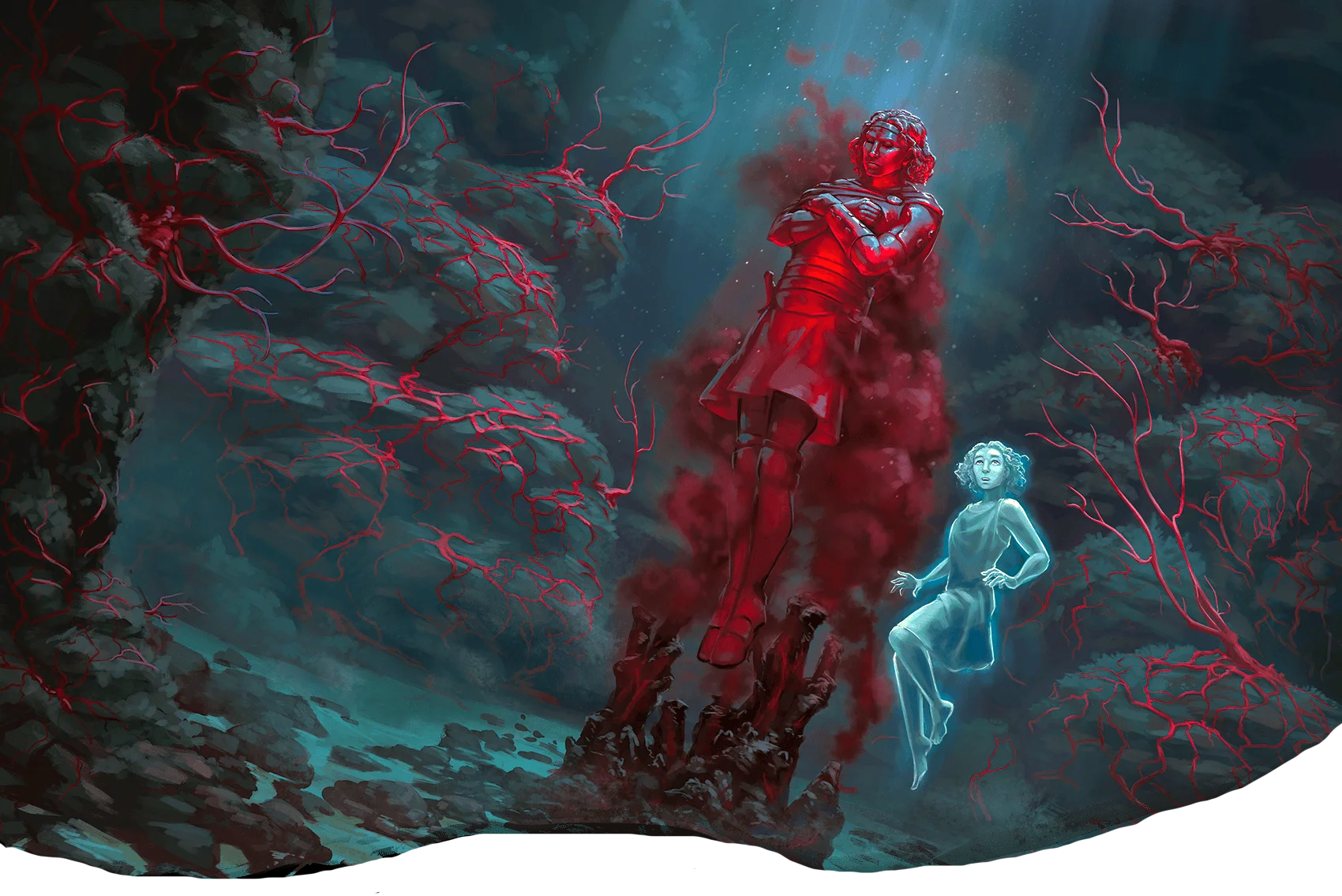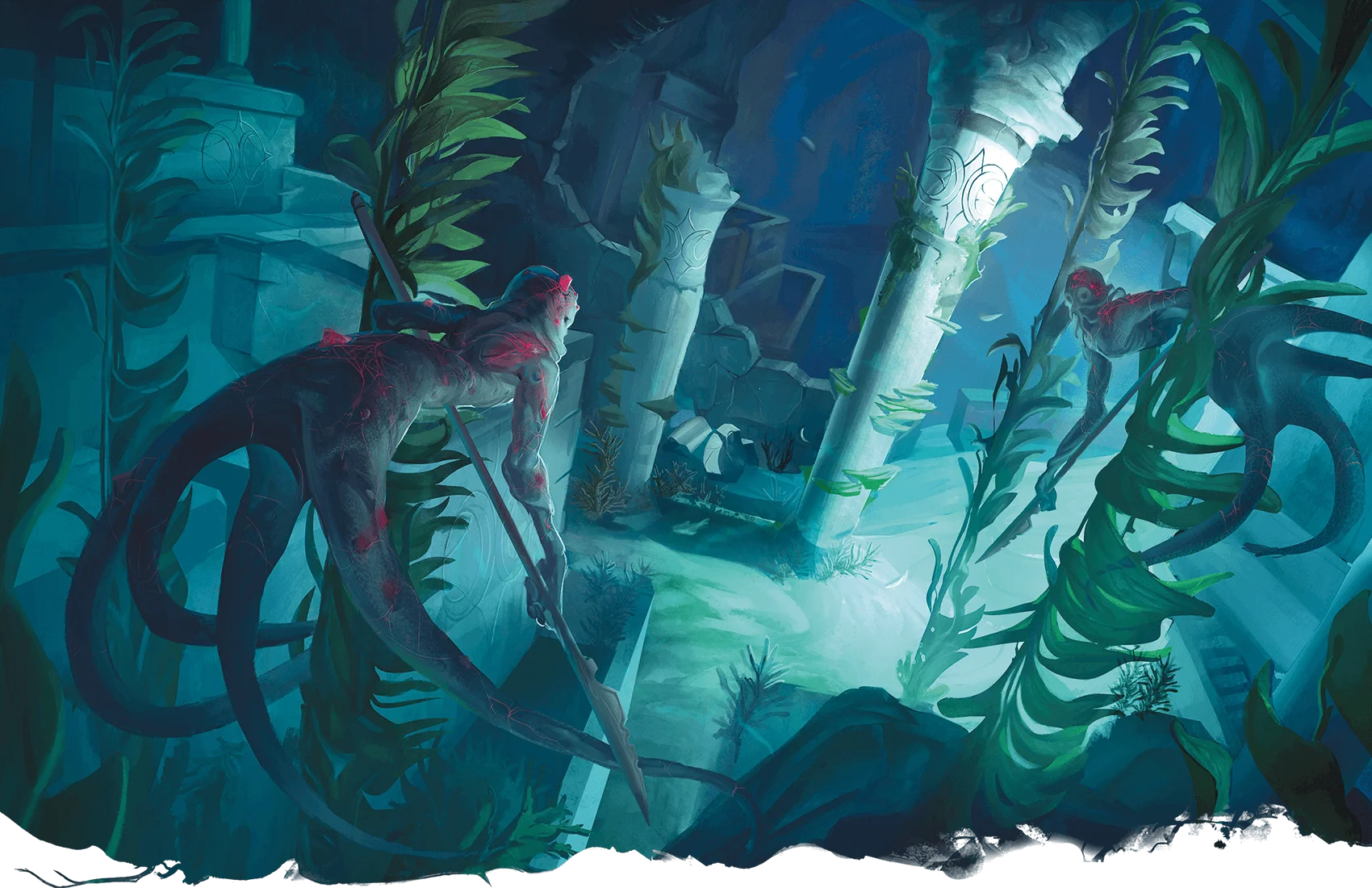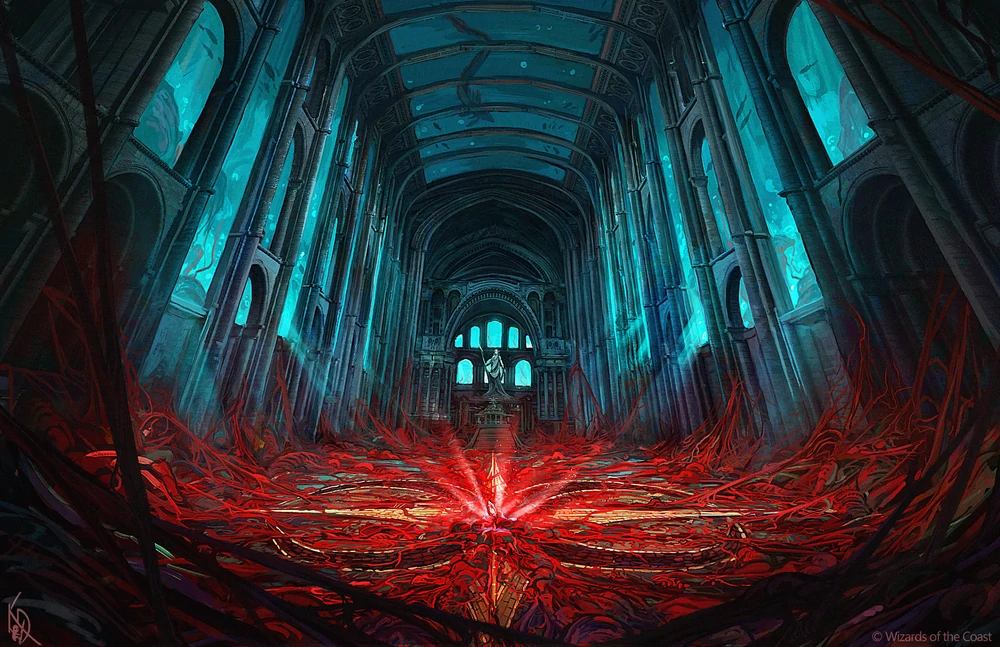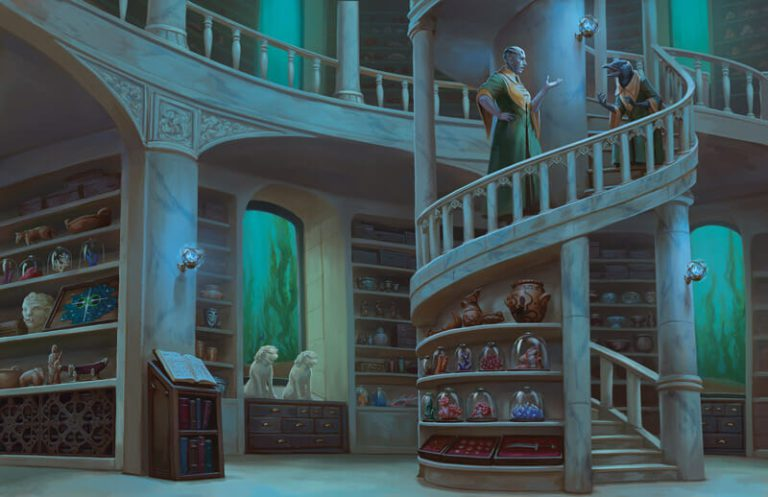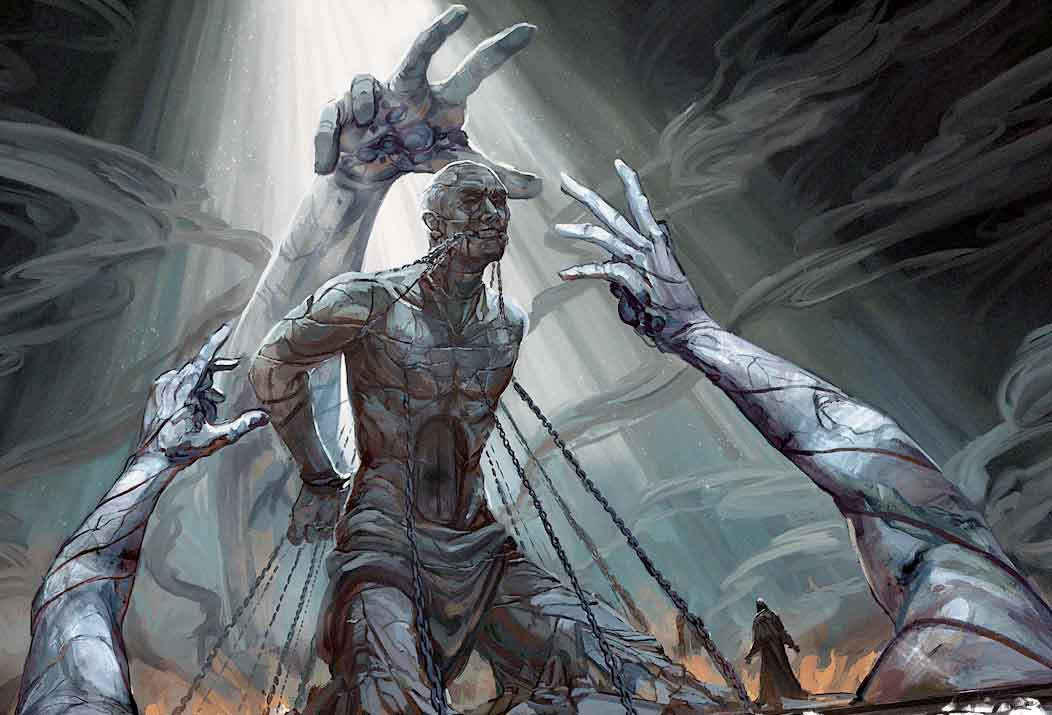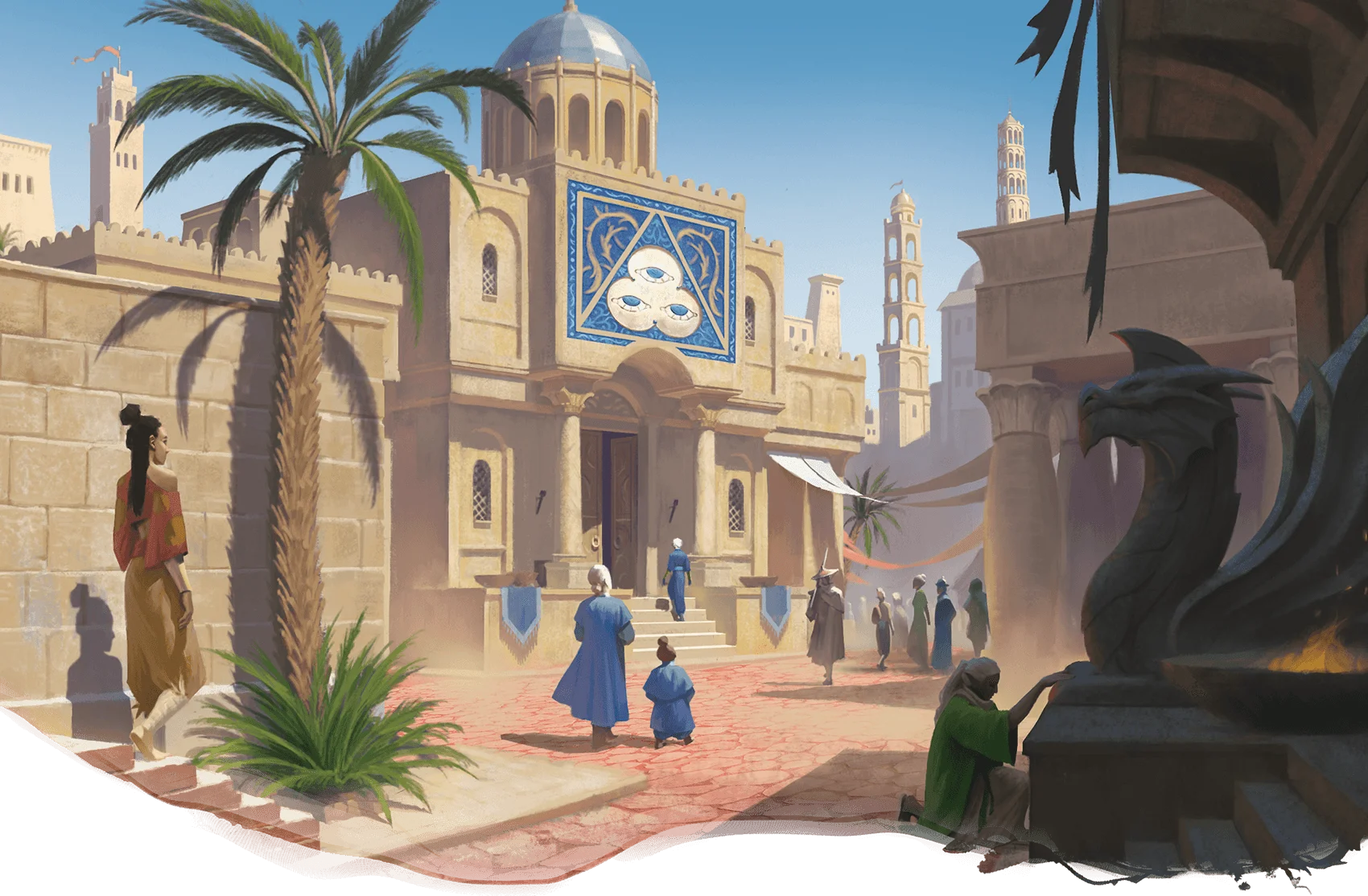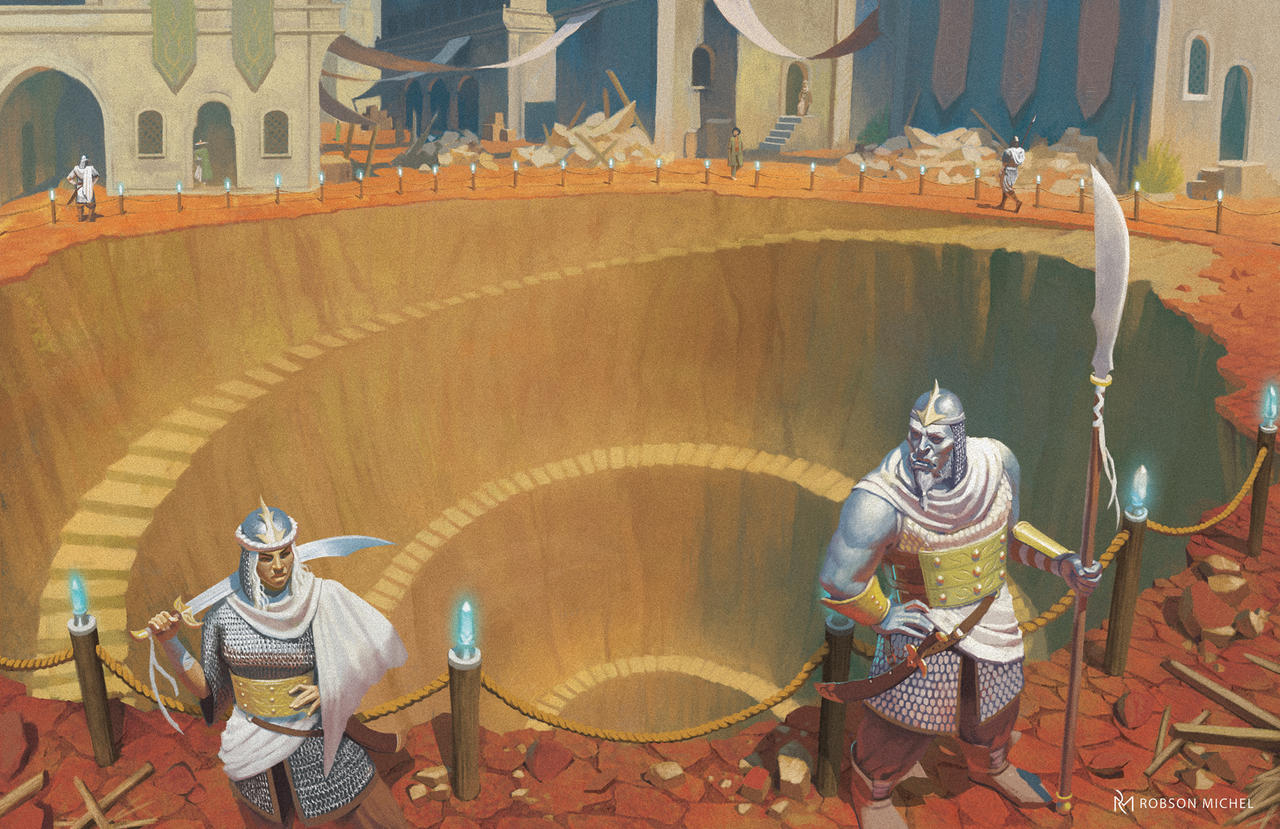
Go to Part 1
As we’ve previously discussed, the core structure of this section of the campaign are the faction missions. Although each faction has a different set of missions, they all follow the same formula:
- Three faction missions in Ank’Harel, followed by three missions in Cael Morrow.
- During the second faction mission, the PCs’ loyalty to their faction will be tested. If they fail, they’ll be booted from the faction and “need” to find another faction to join and do faction missions for.
- The sixth mission is “enter the Netherdeep.”
Unfortunately, these faction missions are, by far, the weakest part of the campaign. They’re plagued by a cluster of problems.
First, there’s the scale mismatch between the design of the faction missions and the design of Cael Morrow. (We’ve already solved this with our pointcrawl remix of the sunken city.)
Second, although the missions are structured to potentially prompt a faction-swap, there’s no clear way for the PCs to hook up with the other factions, because the only mechanism for that is “come to Ank’Harel with a researcher, “ which obviously doesn’t work after you’re already in Ank’Harel.
We’ve made a fair degree of progress on this by making the faction-based play more explicit in Bazzoxan. You can further capitalize on this by perpetuating their relationships with all three researchers: Question, Prolix, and Aloysia shouldn’t just vanish when the action moves to Ank’Harel. Even if the PCs ended up killing one of the researchers in Bazzoxan, how do the researcher’s friends and faction feel about that?
You can also leverage the Rivals here, particularly if they’ve joined one of the other factions. Whether the PCs split from their faction or not, the Rivals may approach and try to convert them to the choice they’ve made. (If the Rivals have been more closely allied to the PCs’ and their faction, then perhaps they fail a loyalty test or are successfully suborned by another faction.)
More than anything, simply establishing the factions and their agendas clearly before the PCs ever get to Ank’Harel will do a lot here. It will empower the PCs to proactively figure out how to contact other factions if the need arises.
The third problem is that the faction missions are extremely simplistic. Their barebones design is often very reminiscent of the similarly minimalist faction missions in Dragon Heist, but whereas the faction missions in Dragon Heist are B-plots that serve as contrapuntal beats to the main action, the Netherdeep faction missions are meant to be the backbone driving the campaign to its ultimate conclusion. It’s really not where you want threadbare, desultory material.
And the final problem with the faction missions is that most of them are just plain bad.
FIXING THE FACTION MISSIONS
To explain what I mean, consider “Hunt for the Truth” (p. 100), where the PCs are trying to identify a double agent in the Allegiance of All-Sight who they believe planted a stolen ring on their friend. They find two pieces of evidence:
- An Insight check reveals that someone has a “guarded expression.”
- This same person, a researcher in the ruidium-infested ruins of Cael Morrow, has a ruidium infection.
The adventure is then over, as the characters can “present their findings to Headmaster Gryz Alakritos.” But… what findings, exactly?
In the next faction mission, “The Double Agent,” the PCs need to track down a double agent and the PCs find two pieces of evidence:
- An Insight check reveals the agent’s “true intentions and affiliation.”
- This same person, a researcher in the ruidium-infested ruins of Cael Morrow, has a ruidium infection.
And if you feel as if the Matrix just glitched, I’m sorry to report that this is not the case: It’s the exact same set up, and the conclusion both times is, “Proof?! Sir, I made an INSIGHT check!”
There are eighteen faction missions in Call of the Netherdeep and I’m not going to break them all down. But you should definitely take a long, hard look at them. I don’t think there are any of the faction missions I would run as-is, and this whole section of the campaign probably needs to be torn down to the foundation, sifted for parts, and then rebuilt from the ground up.
DYNAMIC FACTION MISSIONS
My first instinct with the faction missions is to make them far more dynamic: Rather than a preprogrammed, linear series of fetch quests against a static backdrop, it would be far more interesting if the players’ actions were drastically shifting the balance of power in a back-and-forth struggle with the other factions.
A few things to think about:
Proactive Faction Encounters. Prep some strike teams and/or other proactive elements for the factions. These can become very versatile tools, which you can drop in at any time to complicate the PCs’ lives and create a sense that all of the factions are in constant motion.
Rival Activity. Invoke the Rivals. If you’re following the Principle of Opposition, then even if the Rivals have been working with the PCs up until this point, Ank’Harel will be the point where their disagreement with the PCs about what their goals should be (regarding Alyxian, the ruidium, or both) should really escalate. If it hasn’t happened already, this probably means that the Rivals will end up joining a different faction, becoming one of your proactive faction encounters and almost certainly the NPCs most likely to thwart the PCs’ faction goals.
You can add even more complexity to this idea if friendly Rivals reluctantly join the same faction as the PCs to begin with, but later heel turn as they realize they can’t support the faction’s goals. Alternatively, maybe the Rivals themselves are divided and will end up splitting up across multiple factions. (Maybe the PCs will, too!)
Tip: If you find your game riven with deep philosophical differences about what the “right” thing to do in this section of the campaign is… that’s fantastic! If the divisions between PCs become so great that it feels as if they’re only sticking together because it’s expected, you might explore the possibility of similarly splitting the Rivals and letting players whose characters leave a faction take on the roles of Rivals who stay in the faction. (At your discretion, you can do the inverse with the grouping of PCs + Rivals who join a different faction, following both groups while allowing everyone to continue playing.)
The Other Faction Face. If the PCs are in one faction and the Rivals are in another, it’s possible the third faction will just become a minor player in the campaign. Alternatively, you can give that faction a notable NPC who frequently interacts with the PCs and becomes the “face” of that faction. The appropriate Bazzoxan researcher is probably an easy choice here if they’re available.
Competing for Goals. In framing your faction missions, don’t think only in terms of “what are the PCs trying to do.” Instead, think in terms of something that multiple factions are trying to simultaneously achieve. Once you’ve done that, you can put the opposition in the field and actively play them in competition with the PCs.
Progress clocks may be a good mechanism for tracking how each faction (including the PCs) are doing in the pursuit of their goals. Countdown timers can be used to similar effect (e.g., the PCs need to recover a ruidium artifact before the thieves use it). You may also want to take a peek at scenario structures like Race to the Prize or McGuffin Keep-Away.
You can also increase the dynamic quality of the missions by putting multiple goals into play at the same time. This immediately adds interest by forcing the PCs to choose what goals they’re going to prioritize.
Tip: As you’re looking to strip-mine the faction missions from the book, make sure to look at the faction missions being pursued by the other factions and ask questions like, “What would it look like if the PCs were trying to STOP this from happening?” Also think about how these might flow into the background events of the campaign and how the PCs might become aware of them, creating the sense (and reality!) that stuff is happening in the campaign world even when the players aren’t there to see it.
ANK’HAREL MISSIONS: STAKES & REVELATIONS
The two-phase approach used by the book — of a set of missions taking place in Ank’Harel and then a set of missions focused on Cael Morrow — is probably a good one to retain.
This first phase of the faction missions is about:
- Learning new lore and/or reinforcing or expanding lore they’ve already had a chance to obtain. (This includes stuff like additional Alyxian lore, along with: Where is the ruidium coming from? Where is the entrance to Cael Morrow? What are the goals of the various factions?)
- Testing the PCs’ loyalty to their faction / determining what faction (and goals) they’re ultimately going to pursue.
- Gaining entrance to Cael Morrow.
You’ll want to start by setting up your revelation lists for this phase, and then you can just break the clues down into the missions opportunistically.
During play, seize opportunities to challenge the PCs’ ideology and the goals they’ve chosen. This can take the form of philosophical debates from the Rivals, and so forth, but is also about asking the big question through action: What are you willing to do to achieve your goals? When you see the costs of achieving your goals, is that a price you’re willing to pay?
In terms of gaining entrance to Cael Morrow, I see three primary approaches:
Controlling the Entrance. This is initially the Allegiance of All-Sight. If the PCs have joined the Allegiance, then they simply need to prove their loyalty/value in order to get an access badge. If the PCs are a member of a different faction, then viable entrance strategies would include (a) seizing control of the entrance and/or (b) forming an alliance with the faction who DOES control the entrance (most likely due to some sort of “enemy of my enemy” thing).
Even if the PCs aren’t challenging control of the entrance, consider having one of the other factions do it. (This can also occur during the Cael Morrow phase of the faction missions.)
Sneaking In. I suspect framing this as a straight-up heist scenario is probably the most powerful way to go. One interesting twist on the typical heist scenario here is that it would probably be beneficial for the PCs to figure out a way of accessing Cael Morrow that can be used repeatedly (where a typical heist usually only requires a single break-in).
Find an Alternative Entrance. In the book, the only known entrance to Cael Morrow is through the Maw of Cael Morrow. But it’s a giant underground cave. It’s quite possible that there are other entrances, perhaps leading to daring heist or McGuffin-chase as factions try to get their hands on a journal or map. Or maybe the PCs stumble across the entrance while investigating an anomalous surface outcropping of ruidium.
Note that you can also mix and match here: Maybe the PCs need to sneak in, because they’ve found lore indicating the location of a secret exit from the ruins (and so they need to be in the ruins to track it down and figure out where it leads to on the surface). Or they need to sneak in and install some sort of ruidium-charged teleportation circle so that their faction can teleport into the sunken city.
CAEL MORROW MISSIONS: TERRITORIAL CONTROL
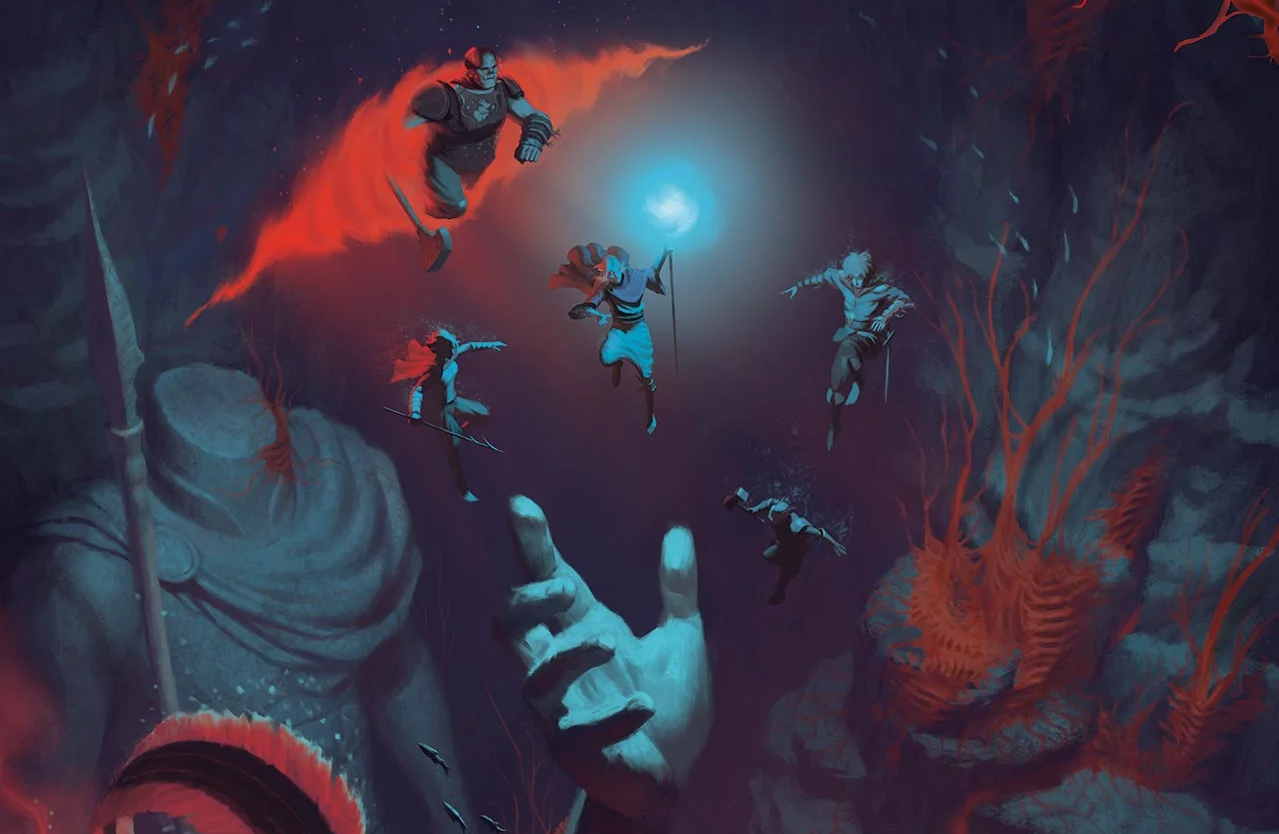
Once the PCs are in Cael Morrow, their mission agendas will include stuff like:
- Epsionage (spy on enemy factions, identify moles, etc.)
- Investigate a known location
- Seek a rumored location (the shrine, the rift, the aboleth’s lair, etc.)
- Retrieve an artifact (or sample of ruidium)
- Eliminate threats (killing monsters, etc.)
By expanding Cael Morrow into a pointcrawl, we’ve probably also given ourselves the breathing room to let the PCs figure out their own goals and pursue them (instead of just completing homework assignments). Think about how you can feed them:
- Information about what the other factions are doing (clues and tracks left in Cael Morrow, captured correspondence, and other such clues).
- Cross-references between pointcrawl locations (e.g., a magical map that survived the city’s fall, notes from another research team, etc.) so that the PCs can set exploration goals.
What I think will help with a lot of this and add a lot of dynamism to this phase of the campaign is adding a layer of territorial control to your pointcrawl map. This means tracking both which locations each faction currently knows about, as well as which faction is currently in “control” of each location (if any).
Faction control should have a tangible effect on the pointcrawl:
- Add a base camp to the location.
- Add a research team that’s investigating the site.
- Add a patrol that’s regularly passing through that area.
- Give the faction access to resources (ruidium, magic items, etc.) that can be gained from the location.
And so forth.
This gives a very simple hook for framing faction missions (e.g., “we need you to eliminate the Cobalt Soul’s security patrol”) and also a clear mechanism for the PCs to have a meaningful effect on the current state of affairs in Cael Morrow (e.g., they take out a security patrol and that means the Cobalt Soul loses control of a key location).
The vibe you’re aiming for here is one part Le Carre spy drama, one part magical Hunt for Red October, one part Ten Thousand Leagues Under the Sea, and one part Bone Wars (but the dinosaur bones are also military weapons tech). Things should feel claustrophobic, enigmatic, and terrifying.
Go to Part 9: Netherdeep Wrap

